![]()
Three Faiths under
One Roof
by Fr. Dave Denny
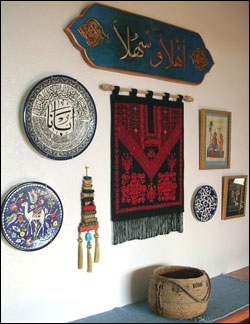 Ever since moving into my new home, which
is called al Hadiyah (Arabic for
“the gift”), I have greeted
visitors with my favorite Arabic greeting:
Ahlan wa sahlan, which means,
roughly translated, “These are your
people and may this be your welcoming land.”
Although it may not be the first thing
you notice, you step into the entry gallery
and onto a red and black carpet given to
me in 1970 in Afghanistan. I was an exchange
student there, and despite having learned
in my orientation not to compliment Afghans
on their belongings, I blurted out one
day in my family’s home in Herat,
“What a beautiful rug!” The
next thing I knew, it was mine. That’s
part of the Afghan code of hospitality:
if a guest admires a host’s possession,
he or she gives it away, even if it costs
the owner dearly. Although I felt some
sheepishness in accepting the gift, I am
grateful. I could not have known at age
seventeen how profoundly my life would
be shaped by those months in a Muslim household
halfway around the world.
Ever since moving into my new home, which
is called al Hadiyah (Arabic for
“the gift”), I have greeted
visitors with my favorite Arabic greeting:
Ahlan wa sahlan, which means,
roughly translated, “These are your
people and may this be your welcoming land.”
Although it may not be the first thing
you notice, you step into the entry gallery
and onto a red and black carpet given to
me in 1970 in Afghanistan. I was an exchange
student there, and despite having learned
in my orientation not to compliment Afghans
on their belongings, I blurted out one
day in my family’s home in Herat,
“What a beautiful rug!” The
next thing I knew, it was mine. That’s
part of the Afghan code of hospitality:
if a guest admires a host’s possession,
he or she gives it away, even if it costs
the owner dearly. Although I felt some
sheepishness in accepting the gift, I am
grateful. I could not have known at age
seventeen how profoundly my life would
be shaped by those months in a Muslim household
halfway around the world.
Contemplative Christianity
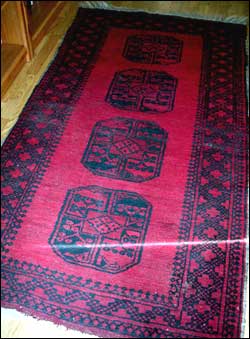 As
I went on to college and university, I
felt drawn to contemplative Christianity,
a tradition that was willing to listen
to and learn from other cultures and religions.
I discovered Thomas Merton and Bede Griffiths.
I hungered for a Christianity that reflected
the wide-open arms of the Jewish rabbi
whom I believe is the embodiment of God.
I could find no condemnation of the “other”
in the Gospel. On the contrary, Jesus shocked
friend and foe by his openness to the “other,”
the alien, the “un-chosen,”
and communicated a sense of truth through
communion and compassion, not through the
unilateral imposition of an ideology. Having
studied Arabic and Islam in college, I
put my interest in the other Abrahamic
traditions aside for decades as I deepened
my immersion in the Carmelite tradition
and the Christian mystics. But after 9/11
and a seismic and shift in my own vocation,
I longed to return to the teachings and
history of the other Abrahamic traditions.
When Tessa Bielecki and I created the Desert
Foundation and I found myself in a new
house that was a blank canvas, I began
to dream about what kind of art might surround
me in this new life.
As
I went on to college and university, I
felt drawn to contemplative Christianity,
a tradition that was willing to listen
to and learn from other cultures and religions.
I discovered Thomas Merton and Bede Griffiths.
I hungered for a Christianity that reflected
the wide-open arms of the Jewish rabbi
whom I believe is the embodiment of God.
I could find no condemnation of the “other”
in the Gospel. On the contrary, Jesus shocked
friend and foe by his openness to the “other,”
the alien, the “un-chosen,”
and communicated a sense of truth through
communion and compassion, not through the
unilateral imposition of an ideology. Having
studied Arabic and Islam in college, I
put my interest in the other Abrahamic
traditions aside for decades as I deepened
my immersion in the Carmelite tradition
and the Christian mystics. But after 9/11
and a seismic and shift in my own vocation,
I longed to return to the teachings and
history of the other Abrahamic traditions.
When Tessa Bielecki and I created the Desert
Foundation and I found myself in a new
house that was a blank canvas, I began
to dream about what kind of art might surround
me in this new life.
Some may imagine that spirituality is not about matter. But Jesus loved lilies, good food and friendship, wine and walking under the sun and stars. In fact, according to John the Evangelist, Jesus incarnated the Word and the Word loved these worldly wonders into being. I recall a poem, “Things,” by Spanish poet Gloria Fuertes: “These things, our things, / how they want to be wanted! / … the door asks to be opened and closed, / the wine to be purchased and drunk, …” I wanted my door to open to a world, not just a house, to things that mean beauty to me, images that want to be wanted, that want to tell stories. I wanted to bring together manifestations of beauty from peoples separated by conflict: the sons and daughters of Abraham, our father in faith. Even if for now we cannot or will not live together in peace and justice, I wanted our handiwork to share a common ground, to suggest a premonition of reconciliation.
Solitude and Hospitality
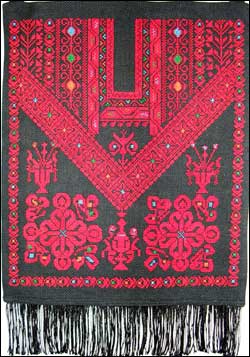 The
first thing you may see when crossing the
threshold of al Hadiyah is an
embroidered cloth hanging with shimmering
red geometrical patterns on a black background.
It was woven by women of Beit Jala, a village
near Bethlehem. Its dominant colors are
the same as the Afghan rug, and although
Afghanistan is far from Palestine, and
its culture is not Semitic, the patterns
of their textiles share similarities. Many
Palestinians of the West Bank and Gaza
Strip cannot enter Jerusalem, so a nonprofit
called Sunbula gathers Palestinian crafts
for sale at a shop sponsored by St. Andrew’s
Church in Jerusalem. That’s where
I found this hanging. Above it hangs an
ornate sign proclaiming “ahlan wa
sahlan” in Arabic calligraphy and
crafted by a Jewish friend, Shahna Lax,
here in Crestone. The greeting may be Arabic,
but it belongs to no single religion or
scripture. It is a simple offering of the
hospitality that reigns throughout the
Middle East and has roots in desert Bedouin
traditions. I want to offer that kind of
hospitality in my home, even though I live
as a solitary.
The
first thing you may see when crossing the
threshold of al Hadiyah is an
embroidered cloth hanging with shimmering
red geometrical patterns on a black background.
It was woven by women of Beit Jala, a village
near Bethlehem. Its dominant colors are
the same as the Afghan rug, and although
Afghanistan is far from Palestine, and
its culture is not Semitic, the patterns
of their textiles share similarities. Many
Palestinians of the West Bank and Gaza
Strip cannot enter Jerusalem, so a nonprofit
called Sunbula gathers Palestinian crafts
for sale at a shop sponsored by St. Andrew’s
Church in Jerusalem. That’s where
I found this hanging. Above it hangs an
ornate sign proclaiming “ahlan wa
sahlan” in Arabic calligraphy and
crafted by a Jewish friend, Shahna Lax,
here in Crestone. The greeting may be Arabic,
but it belongs to no single religion or
scripture. It is a simple offering of the
hospitality that reigns throughout the
Middle East and has roots in desert Bedouin
traditions. I want to offer that kind of
hospitality in my home, even though I live
as a solitary.

This copper and blue-green
enamel sign mounted on cedar, created by
Shahna Lax, displays the Arabic greeting
“Ahlan wa Sahlan.” These fluid
copper letters tumble across the enamel
like sunlight on blue water to greet visitors
to my hermitage.
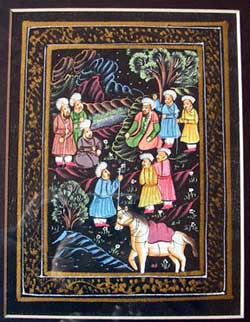 The
wall includes a small Persian miniature
of nine men meeting on a verdant hillside.
A white pony stands in the foreground beside
a stream. Like my rug, it reminds me of
Afghanistan. I remember standing with my
Afghan “brother,” Syed Ahmad,
one evening thirty-seven years ago at a
place called Bagha Bala (High Garden) outside
Kabul. The heat of the day waned; a breeze
blew through the fruit trees; the lights
of kerosene lamps began to appear from
within the flat-roofed adobe homes below
us. The full moon rose, and I felt I was
inside a Persian miniature, a landscape
and atmosphere that, until that moment,
would have seemed purely fictional to me,
a son of the green flat farmlands of northern
Indiana.
The
wall includes a small Persian miniature
of nine men meeting on a verdant hillside.
A white pony stands in the foreground beside
a stream. Like my rug, it reminds me of
Afghanistan. I remember standing with my
Afghan “brother,” Syed Ahmad,
one evening thirty-seven years ago at a
place called Bagha Bala (High Garden) outside
Kabul. The heat of the day waned; a breeze
blew through the fruit trees; the lights
of kerosene lamps began to appear from
within the flat-roofed adobe homes below
us. The full moon rose, and I felt I was
inside a Persian miniature, a landscape
and atmosphere that, until that moment,
would have seemed purely fictional to me,
a son of the green flat farmlands of northern
Indiana.
 Pottery
and Paradise
Pottery
and Paradise
Three ceramic plates hang on the wall.
Made by Christian potters in Bethlehem,
one is glazed with the Our Father in Arabic.
I have memorized the first Sura of the
Qur’an; it’s time I memorized
the Our Father in Arabic. A simple blue
and black floral pattern covers a smaller
dish, testifying to desert dwellers’
fascination with flowers and gardens: a
reminder that our word “paradise”
comes from the Persian word for garden.
A stately white camel stands in silhouette
against a floral background on the third.
This appeals to me for two reasons. Most
immediately, it reminds me of March 2000,
when I rode a camel for two days in the
desert of Wadi Rum, near Aqaba, Jordan.
Seated high on the camel’s back I
wandered through a maze of sun-drenched
and shadowed red cliffs on sands that shifted
from beige to ochre to rust. Spring rains
allowed tiny wildflowers to spring up in
impossible crannies of sand and stone.
Before and after my little expedition,
my teen-aged camel driver’s mother
sat me down next to her charcoal fire in
her enclosed patio to drink sweet hot tea
spiced with sage.
But the camel also reminds me of the Jewish
tradition, of their sojourn in Sinai, and
Isaiah’s vision of the day when all
nations will come to Jerusalem, drawn by
the truth and light it radiates:
Then you will see and be radiant,
And your heart will thrill and rejoice;
Because the abundance of the sea will be
turned to you,
The wealth of the nations will come to
you.
A multitude of camels will cover you,
The young camels of Midian and Ephah;
All those from Sheba will come;
They will bring gold and frankincense,
And will bear good news of the praises
of the Lord.
(Isaiah 60: 5-6)
Sanctuary, Not Separation
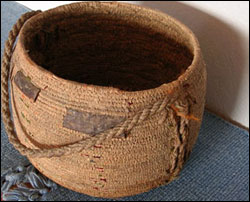 On
the center of the bookshelf as you enter
lies a worn and empty basket. It
comes from the Egyptian oasis of Siwa,
an ancient settlement visited by
Alexander the Great before there was such
a thing as a Christian or a
Muslim. It is tattered but tightly woven.
I like to think it holds nothing
but Promise.
On
the center of the bookshelf as you enter
lies a worn and empty basket. It
comes from the Egyptian oasis of Siwa,
an ancient settlement visited by
Alexander the Great before there was such
a thing as a Christian or a
Muslim. It is tattered but tightly woven.
I like to think it holds nothing
but Promise.
A wall can be a terrible thing. I want the wall that people see when entering my home to be a sign not of separation, but of sanctuary, protection, hospitality. I want it to show that beauty is not monopolized by one tradition, but shared by all. I want it to show you what Paradise might look like through the prism of my desert sojourns with Jews, Muslims, and Christians in our troubled Abrahamic family.